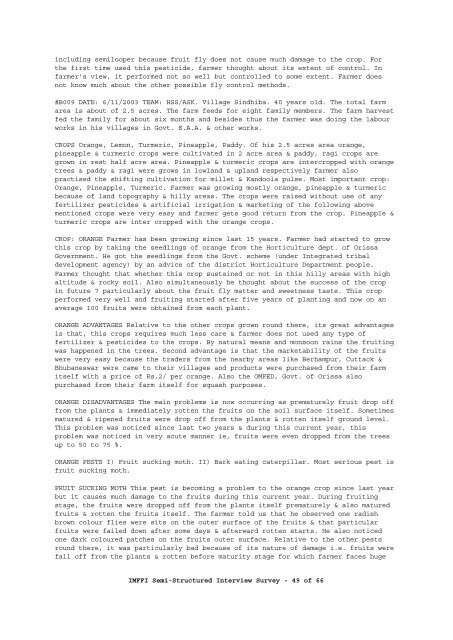“Key Informant Survey” of Production, Value, Losses and ... - DfID
“Key Informant Survey” of Production, Value, Losses and ... - DfID
“Key Informant Survey” of Production, Value, Losses and ... - DfID
Create successful ePaper yourself
Turn your PDF publications into a flip-book with our unique Google optimized e-Paper software.
including semilooper because fruit fly does not cause much damage to the crop. For<br />
the first time used this pesticide, farmer thought about its extent <strong>of</strong> control. In<br />
farmer's view, it performed not so well but controlled to some extent. Farmer does<br />
not know much about the other possible fly control methods.<br />
#B009 DATE: 6/11/2003 TEAM: HSS/ASK. Village Sindhiba. 40 years old. The total farm<br />
area is about <strong>of</strong> 2.5 acres. The farm feeds for eight family members. The farm harvest<br />
fed the family for about six months <strong>and</strong> besides thus the farmer was doing the labour<br />
works in his villages in Govt. E.A.A. & other works.<br />
CROPS Orange, Lemon, Turmeric, Pineapple, Paddy. Of his 2.5 acres area orange,<br />
pineapple & turmeric crops were cultivated in 2 acre area & paddy, ragi crops are<br />
grown in rest half acre area. Pineapple & turmeric crops are intercropped with orange<br />
trees & paddy & ragi were grows in lowl<strong>and</strong> & upl<strong>and</strong> respectively farmer also<br />
practised the shifting cultivation for millet & K<strong>and</strong>oola pulse. Most important crop:<br />
Orange, Pineapple, Turmeric. Farmer was growing mostly orange, pineapple & turmeric<br />
because <strong>of</strong> l<strong>and</strong> topography & hilly areas. The crops were raised without use <strong>of</strong> any<br />
fertilizer pesticides & artificial irrigation & marketing <strong>of</strong> the following above<br />
mentioned crops were very easy <strong>and</strong> farmer gets good return from the crop. Pineapple &<br />
turmeric crops are inter cropped with the orange crops.<br />
CROP: ORANGE Farmer has been growing since last 15 years. Farmer had started to grow<br />
this crop by taking the seedlings <strong>of</strong> orange from the Horticulture dept. <strong>of</strong> Orissa<br />
Government. He got the seedlings from the Govt. scheme (under Integrated tribal<br />
development agency) by an advice <strong>of</strong> the district Horticulture Department people.<br />
Farmer thought that whether this crop sustained or not in this hilly areas with high<br />
altitude & rocky soil. Also simultaneously he thought about the success <strong>of</strong> the crop<br />
in future 7 particularly about the fruit fly matter <strong>and</strong> sweetness taste. This crop<br />
performed very well <strong>and</strong> fruiting started after five years <strong>of</strong> planting <strong>and</strong> now on an<br />
average 100 fruits were obtained from each plant.<br />
ORANGE ADVANTAGES Relative to the other crops grown round there, its great advantages<br />
is that, this crops requires much less care & farmer does not used any type <strong>of</strong><br />
fertilizer & pesticides to the crops. By natural means <strong>and</strong> monsoon rains the fruiting<br />
was happened in the trees. Second advantage is that the marketability <strong>of</strong> the fruits<br />
were very easy because the traders from the nearby areas like Berhampur, Cuttack &<br />
Bhubaneswar were came to their villages <strong>and</strong> products were purchased from their farm<br />
itself with a price <strong>of</strong> Rs.2/ per orange. Also the OMFED, Govt. <strong>of</strong> Orissa also<br />
purchased from their farm itself for squash purposes.<br />
ORANGE DISADVANTAGES The main problems is now occurring as prematurely fruit drop <strong>of</strong>f<br />
from the plants & immediately rotten the fruits on the soil surface itself. Sometimes<br />
matured & ripened fruits were drop <strong>of</strong>f from the plants & rotten itself ground level.<br />
This problem was noticed since last two years & during this current year, this<br />
problem was noticed in very acute manner ie, fruits were even dropped from the trees<br />
up to 50 to 75 %.<br />
ORANGE PESTS I) Fruit sucking moth. II) Bark eating caterpillar. Most serious pest is<br />
fruit sucking moth.<br />
FRUIT SUCKING MOTH This pest is becoming a problem to the orange crop since last year<br />
but it causes much damage to the fruits during this current year. During fruiting<br />
stage, the fruits were dropped <strong>of</strong>f from the plants itself prematurely & also matured<br />
fruits & rotten the fruits itself. The farmer told us that he observed one radish<br />
brown colour flies were sits on the outer surface <strong>of</strong> the fruits & that particular<br />
fruits were failed down after some days & afterward rotten starts. He also noticed<br />
one dark coloured patches on the fruits outer surface. Relative to the other pests<br />
round there, it was particularly bad because <strong>of</strong> its nature <strong>of</strong> damage i.e. fruits were<br />
fall <strong>of</strong>f from the plants & rotten before maturity stage for which farmer faces huge<br />
IMFFI Semi-Structured Interview Survey - 49 <strong>of</strong> 66

















